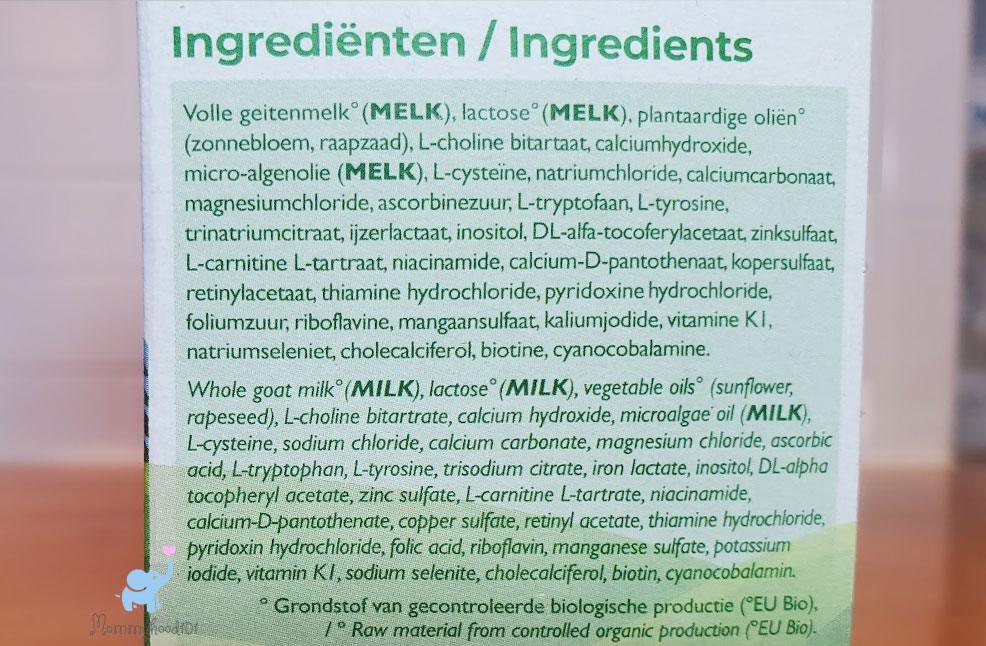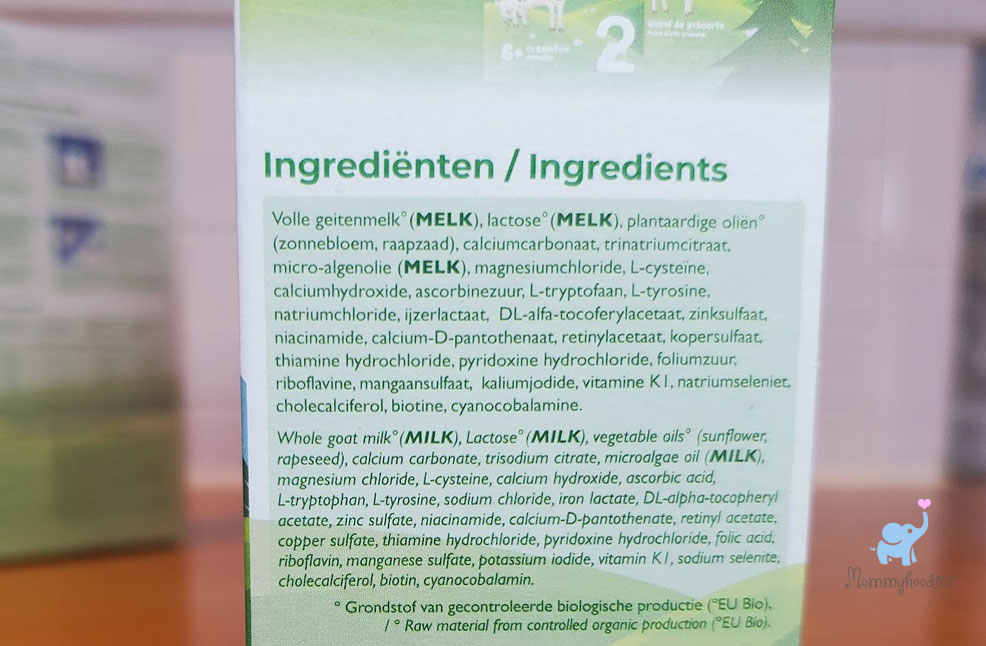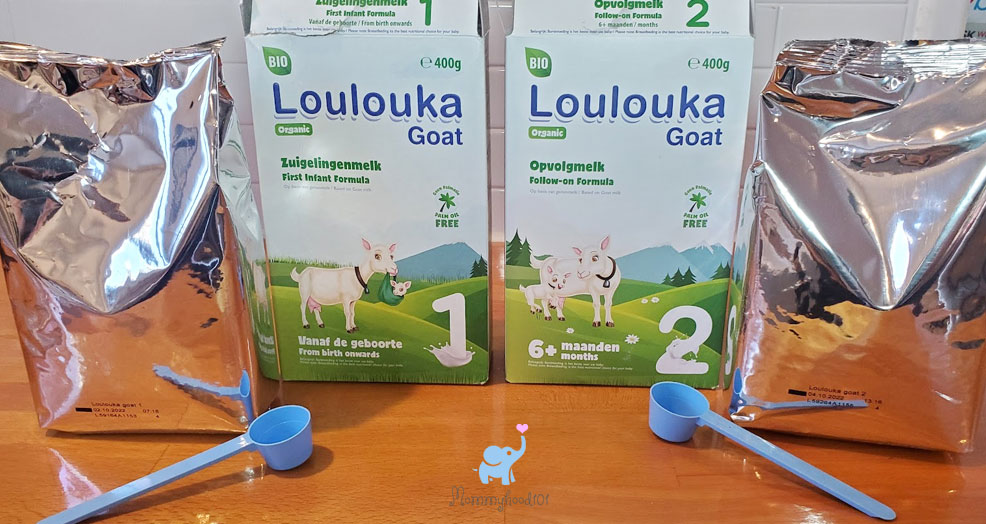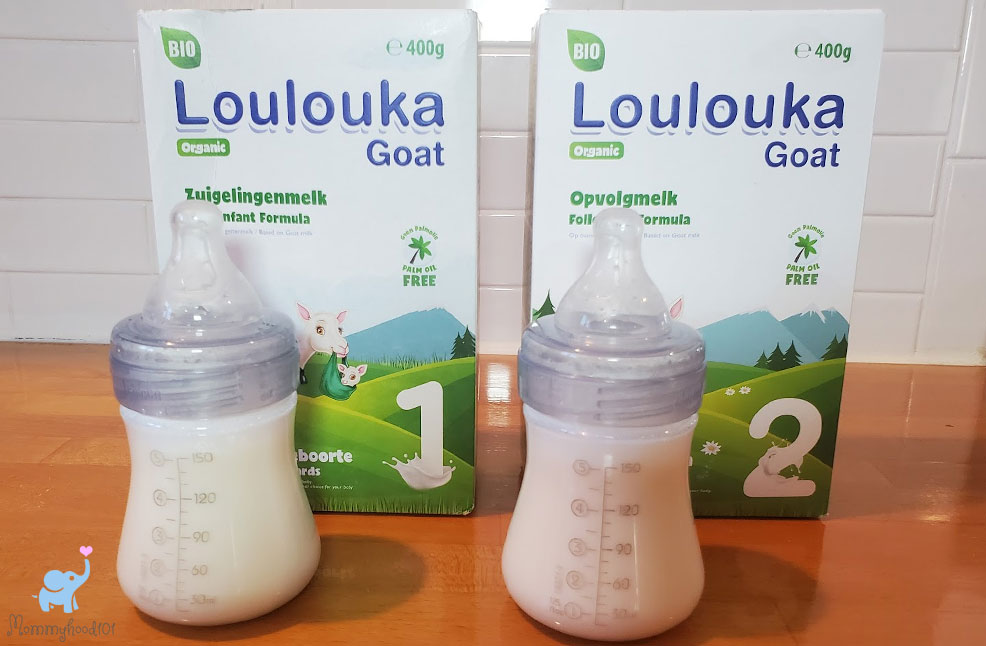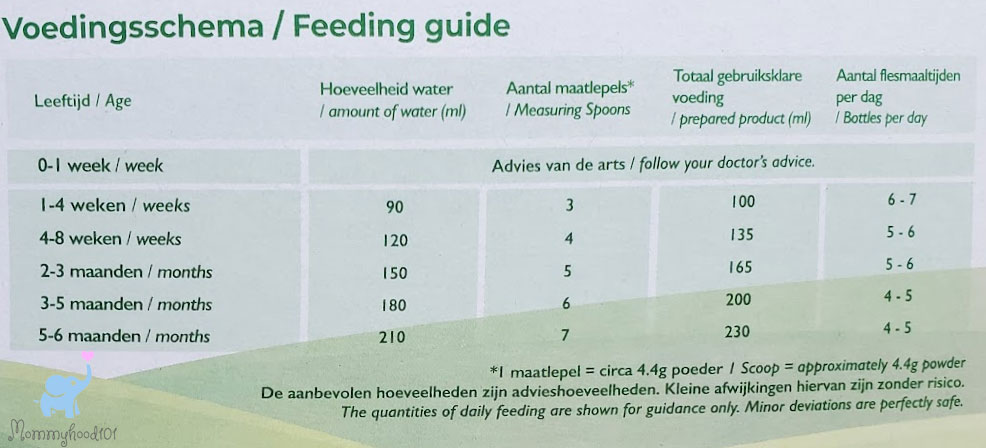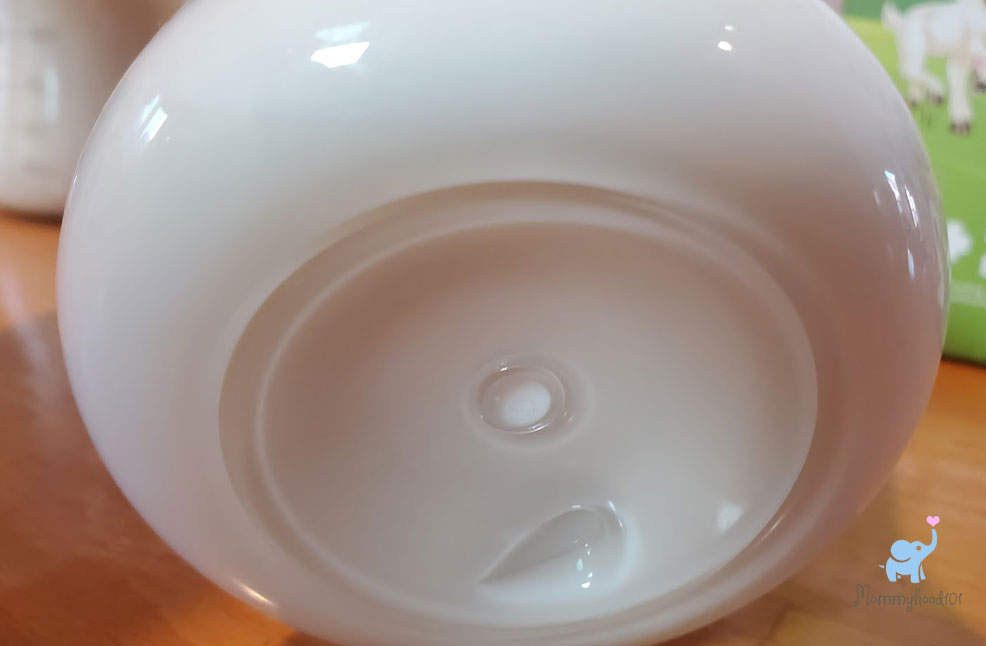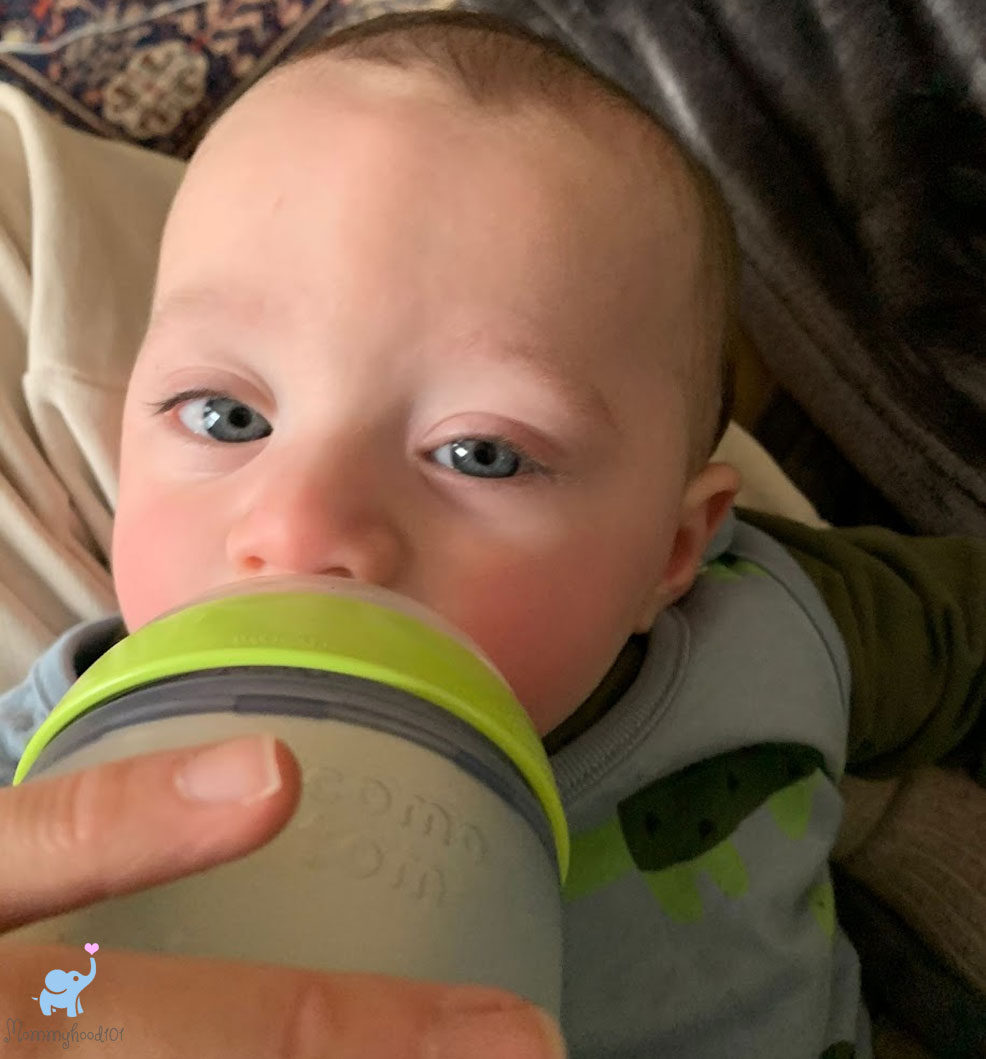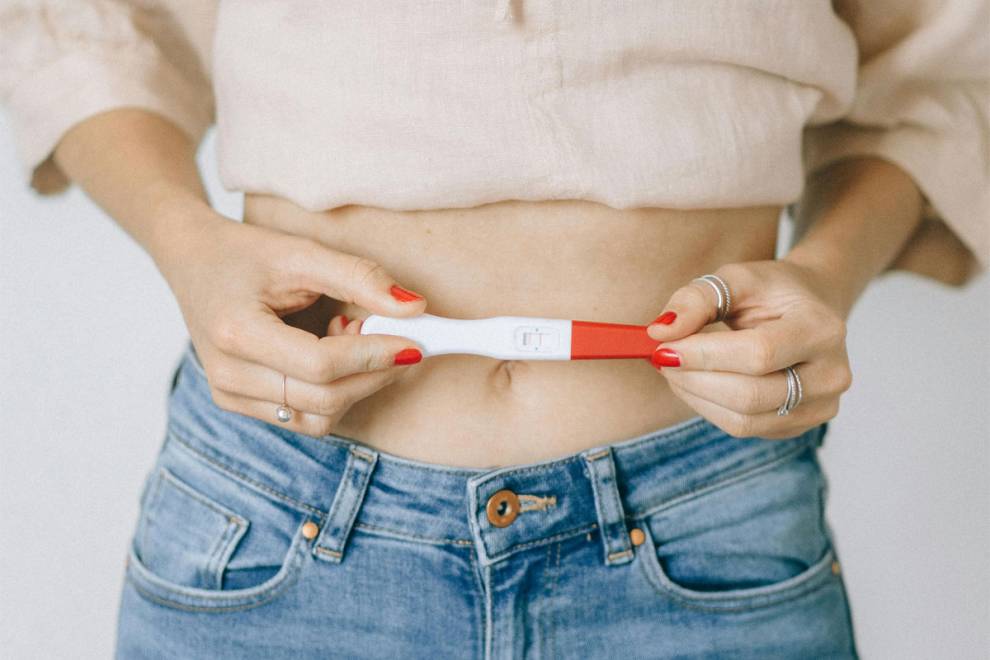A new option for a sensitive tummy, we try the popular Loulouka goat formula.

Mommyhood101 independently tests and curates baby gear to help you make informed decisions. If you buy products through links on our site, we may earn a commission.
Alert: Loulouka formulas (original and goat) have been discontinued indefinitely. There are some rumors as of 2023, however, that Loulouka might be returning by the end of the year. We'll keep you updated!
Loulouka goat milk infant formulas are made in Austria using premium goat milk sourced from organic farms in the Swiss Alps.
Like all Loulouka products, Loulouka goat formulas maintain stringent organic and non-GMO certification, wholesome nutrition, and a simple ingredients list that is very popular among discerning parents of little ones with gentle tummies!
-
- Loulouka Goat Comparison Table
- Take-Home Message
- Some Translations to Know
- Loulouka Goat Farming Practices
- EU Organic Regulations
- Loulouka Goat Ingredients
- Loulouka Goat Stage 1 Ingredients
- Loulouka Goat Stage 2 Ingredients
- Loulouka Goat Stages: Ingredient Differences
- Loulouka Goat Nutritional Analysis
- FDA & USDA Formula Recommendations
- Loulouka Goat Stage 1 Nutrition
- Loulouka Goat Stage 2 Nutrition
- Loulouka Goat Stage 3 Nutrition
- Loulouka Goat Formula Testing in Infants
- Conclusions
- Where to Buy Loulouka Goat
- References Cited
Loulouka prides themselves on being the only major goat milk baby formula that exclusively uses high quality Swiss whole cream goat milk and maintains stringent EU organic Bio certification. But how does it perform!?
In our hands-on review of the Loulouka Goat formulas, just like we did in our Jovie Goat formula review, Kendamil Goat formula review, and Nannycare Goat formula review, we tested Stages 1 and 2 of this popular goat milk formula with two infants and a toddler, tasted them ourselves (we always do!), and consulted with a developmental nutritionist to assess ingredients and nutritional contents relative to FDA and USDA guidelines.
Loulouka Goat offers three stages of goat milk formula, both of which use whole goat milk and lactose: Stage 1 (birth onward) and Stage 2 (6 months onward).
Overall, we give the two Loulouka Goat milk formulas a 4.7 out of 5, which is an extremely high rating for our site! In fact, it's good enough to appear in a great position in our new list of the best goat milk formulas!
Loulouka Goat Formulas: Take-home Message
Most people don't want to read this entire article to see what we found. So here is the summary of what we loved, and what we didn't.
✔️ Certified organic ingredients.
✔️ Full cream whole goat milk.
✔️ A2 Beta Caseins.
✔️ Nutrition at FDA standards.
✔️ First ingredient is whole goat milk.
✔️ Nothing artificial.
✔️ No maltodextrin or starch.
✔️ No sucrose or corn syrups.
✔️ Gluten & soy free.
✔️ No palm or M. Alpina oils.
✔️ Omega-3 via DHA & ALA.
✔️ Omega-6 via LA.
✔️ Inositol & Choline.
✔️ Amino Acids.
✔️ High infant acceptance, good taste.
✔️ No gas, indigestion, or constipation.
❌ No added prebiotics.
❌ No added probiotics.
❌ 20:80 Whey to Casein ratio.
Loulouka Goat Formulas: Some Translations
Because Loulouka Goat formulas are made in Austria and labeled for sale in The Netherlands, so their labels are written in Dutch.
Fortunately for the English speakers in the group, Loulouka Goat labels are completely translated to English right on the box!
While no translation is required, there are a few terms on the packaging you might be wondering about:
BIO: This means organic in the EU, and also is the major governing body for organic certification in the EU, following a stringent set of testing, certification, and monitoring practices.
Zuigelingenmelk: Zuigelingen means infants, and you guessed it, Melk means milk! Together, that is translated as "infant milk" or "first infant formula."
One of the biggest challenges with choosing a European baby formulas is difficulty reading the labels (such as with HiPP and Holle), but that problem is conveniently solved with Loulouka goat formulas!
Loulouka Goat Formulas: Best Practices?
Loulouka Goat formulas, just like you learned in our regular Loulouka formula review, are made in Austria by a company called Potentia Trium located in The Netherlands.
Loulouka Goat uses only organic Swiss goat milk and EU certified (Bio) organic ingredients.
The European Union (EU) has more stringent organic regulations than the USDA Organic certification (shown below).

Organic certification in the EU requires meeting a minimum of 98% organic content (by weight).
In contrast, in the United States, the USDA requires a minimum of 95% organic content. That means Loulouka Goat formula likely has about 3% more organic content than baby formulas that are USDA certified organic.
Loulouka Goat Organic Certifications
In addition to the organic certification process being more stringent in the EU than in the USA, the strict set of organic controls is also inspected and enforced on an annual basis, resulting in renewed annual certificates.
Because Austria, where Loulouka Goat is produced, is part of the EU, the organic (BIO) certification requires that:
- No synthetic chemicals such as herbicides or pesticides can be used on plants.
- No soluble mineral fertilizers can be used.
- No chemical growth regulators can be used.
- Animals must be fed with farm-grown feed, not purchased feed, whenever possible.
- Other than to treat acute infection, antibiotics cannot be used.
The Loulouka Goat formulas are EU organic certified by Austria Bio Guaranty, bearing the label AT-BIO-301. Bio Guaranty is a registered Austrian inspection body for organic products, and is located in Vienna, Austria.
Loulouka Goat Formula Ingredients
Loulouka Goat milk formulas use very simple ingredients, without any added fillers.
They use full cream A2 whole goat milk as the first ingredient, then lactose.
No whey or whey powder is added, which results in Loulouka goat formulas not achieving the preferred 60:40 whey to casein ratio that is found in breast milk. Instead, they have a 20:80 ratio, similar to Nannycare goat formula, with far more casein than whey. This is in contrast to what we found in our Kendamil goat formula review, which was 60:40 whey to casein, and in our Kabrita infant formula review, which was 50:50 whey to casein.
That being said, Loulouka Goat formulas have managed to keep out all the nasty stuff: no starches or maltodextrin, no palm or soybean oils, and no added sugars or corn syrup solids.
We love that, and we think your little one will love it too!
Here are the ingredients in each of the Loulouka Goat baby formulas (as of 2022):
Loulouka Goat Stage 1 Ingredients: Whole Goat Milk (Milk), Lactose (Milk), Vegetable Oils (Sunflower, Rapeseed), L-Choline Bitartrate, Calcium Hydroxide, Microalgae (Milk), L-Cysteine, Sodium Chloride, Calcium Carbonate, Magnesium Chloride, Ascorbic Acid, L-Tryptophan, L-Tyrosine, Trisodium Citrate, Iron Lactate, Inositol, DL-alpha Tocopheryl Acetate (Vitamin E), Zinc Sulfate, L-Carnitine L-Tartrate, Niacinamide (Vitamin B-3), Calcium-D-Pantothenate, Copper Sulfate, Retinyl Acetate (Vitamin A), Thiamine Hydrochloride (Vitamin B1), Pyridoxin Hydrochloride (Vitamin B), Folic Acid, Riboflavin, Manganese Sulfate, Potassium Iodide, Vitamin K1, Sodium Selenite, Cholecalciferol (Vitamin D3), Biotin, Cyanocobalamin (Vitamin B12).
Note: For allergens, see ingredients in Bold.
Loulouka Goat Stage 2 Ingredients: Whole Goat Milk (MILK), Lactose (MILK), Vegetable Oils* (Sunflower, Rapeseed), Calcium Carbonate, Trisodium Citrate, Microalgae Oil (MILK), Magnesium Hydrochloride, L-Cysteine, Calcium Hydroxide, Vitamin C, L-Tryptophan, L-Tyrosin, Sodium Chloride, Iron Lactate, Vitamin E, Zinc Sulfate, Niacinamide (Vitamin B-3), Calcium D-Pantothenate, Retinyl Acetate (Vitamin A), Copper Sulfate, Thiamine Hydrochloride (Vitamin B1), Pyridoxine Hydrochloride (Vitamin B), Folic Acid, Riboflavin, Mangenese Sulfate, Potassium Iodide, Vitamin K1, Sodium Selenite, Cholecalciferol (Vitamin D3), Biotin, Cyanocobalamin (Vitamin B12).
Note: For allergens, see ingredients in Bold.
Here are some ingredients that we did not find in any stages of Loulouka Goat formula: corn syrup or corn syrup solids, artificial colors, artificial flavors, preservatives, sucrose, soy, gluten, palm oil, starch, maltodextrin, carrageenan, or high fructose corn syrup.
Some ingredients we didn't appreciate:
Loulouka uses something called "microalgae oil," which from our understanding is the same as Crypthecodinium cohnii (C. Cohnii) oil.
C. Cohnii oil is an Omega-3 (DHA) source derived from the fermentation of algae plants. The challenge, in some parents' opinions, is that the extraction of C. cohnii oil from algae often involves the toxic industrial chemical hexane. While there is no evidence that hexane is detectable in C. cohnii oil, some parents prefer that fish oil is used rather than C. cohnii, or that the C. cohnii is extracted from algae using water-based rather than hexane-based methods.
Some other ingredients worth mentioning:
Prebiotics via GOS: We prefer baby formulas that include prebiotics to aid in digestion, such as by including galactooligosaccharides (GOS), which are dietary prebiotics that help promote a healthy gut microbiome through benefits to intestinal microbiota and gut barrier function. Note that Loulouka Goat formulas do not include GOS prebiotics.
However, whole cream A2 goat milk also naturally contains an abundance of prebiotics, which likely helps with digestibility of this formula.
Fluoride: Loulouka goat formula doesn't add fluoride, though it is naturally present in very small amounts (less than 0.073 mg per 100ml of formula). More on that later.
Loulouka Goat Stages: Ingredient Differences
1. Loulouka Goat Stage 1 versus Stage 2: The first two Loulouka goat stages are basically identical for primary ingredients.
However, there are some differences when it comes to amino acids, choline, and inositol. Specifically, Stage 2 removes choline and inositol, has fewer amino acids overall, and removes two specific amino acids entirely: L-carnitine and L-tartrate.
Loulouka Goat Formula Nutritional Analysis
To examine whether Loulouka goat baby formulas come close to the stringent US nutritional recommendations put forth by the US Department of Agriculture (USDA, see references), Food and Drug Administration (FDA), and American Academy of Pediatrics (AAP), we consulted with a dietician nutritionist with expertise in infant feeding (Mr. John Anderson).
Note that the FDA publishes guidance in 21 U.S. Code 350a regarding nutrient requirements in infant formula. This regulation includes minimum protein, fat (and fatty acid linoleate) content. It also includes ranges for 15 vitamins and 11 minerals.
Here are the FDA requirements per 100 kilocalories of formula (see references).
FDA Nutritional Requirements:
| Protein | 0-6mo: 1.8g to 4.5g |
| Fat | 0-6mo: 3.3g to 6.0g (≥ 30% of calories) |
| Essential Fatty Acid (LA Omega-6) | 0-6mo: ≥300mg (≥2.7% of calories) |
| Vitamin A | 0-6mo: 250IU to 750IU (75-225μg if retinol) |
| Vitamin D | 0-6mo: 40IU to 100IU |
| Vitamin K | 0-6mo: ≥4μg |
| Vitamin E | 0-6mo: 0.7IU |
| Vitamin C | 0-6mo: ≥8mg |
| Vitamin B1 | 0-6mo: ≥40μg |
| Vitamin B2 | 0-6mo: ≥60μg |
| Vitamin B6 | 0-6mo: ≥35μg |
| Vitamin B12 | 0-6mo: ≥0.15μg |
| Niacin | 0-6mo: ≥250μg |
| Folic Acid | 0-6mo: ≥4μg |
| Pantothenic Acid | 0-6mo: ≥300μg |
| Biotin | 0-6mo: ≥1.5μg (for non-milk-based formulas) |
| Choline | 0-6mo: ≥7mg (for non-milk-based formulas) |
| Inositol | 0-6mo: ≥4mg (for non-milk-based formulas) |
| Calcium | 0-6mo: ≥50mg |
| Phosphorus | 0-6mo: ≥25mg |
| Magnesium | 0-6mo: ≥6mg |
| Iron | 0-6mo: ≥0.15mg |
| Iodine | 0-6mo: ≥5μg |
| Zinc | 0-6mo: ≥0.5mg |
| Copper | 0-6mo: ≥60μg |
| Manganese | 0-6mo: ≥5μg |
| Sodium | 0-6mo: 20mg to 60mg |
| Potassium | 0-6mo: 80mg to 200mg |
| Chloride | 0-6mo: 55mg to 150mg |
In reviewing Loulouka goat Stage 1 formula, using a 1.47 multiplier relative to their nutrition facts label (to equal 100kcal of formula), we found that the Loulouka Stage 1 infant formula met all of the minimum FDA nutritional requirements (and did not exceed any of their maximums).
Note that the FDA calls for Folic Acid of at least 4 micrograms per 100kcal of formula; Loulouka Goat contains folic acid on the ingredients list, and their nutritional label uses the same term. Folic acid is the synthetic form of folate.
The USDA does not publish recommended daily allowances (RDAs) for infants between 0-6 months. Instead, they publish information about Adequate Intake (AI), which is used when there is not enough evidence to make a formal RDA. The AI is set at a level assumed to provide nutritional adequacy.
Here are the USDA's AIs (per day) for infants aged 0-6 months, and 6-12 months. Units are grams (g), milligrams (mg), micrograms (μg).
USDA Nutritional Recommendations:
| Carbohydrates | 0-6mo: 60g | 6-12mo: 95g |
| Proteins | 0-6mo: 9.1g | 6-12mo: 11g |
| Fats | 0-6mo: 31g | 6-12mo: 30g |
| Omega-3 | 0-6mo: 0.5g | 6-12mo: 0.5g |
| Omega-6 | 0-6mo: 4.4g | 6-12mo: 4.6g |
| Vitamin A | 0-6mo: 400μg | 6-12mo: 500μg |
| Vitamin B1 | 0-6mo: 0.2mg | 6-12mo: 0.3mg |
| Vitamin B2 | 0-6mo: 0.3mg | 6-12mo: 0.4mg |
| Vitamin B6 | 0-6mo: 0.1mg | 6-12mo: 0.3mg |
| Vitamin B12 | 0-6mo: 0.4μg | 6-12mo: 0.5μg |
| Vitamin C | 0-6mo: 40mg | 6-12mo: 50mg |
| Vitamin D | 0-6mo: 5μg | 6-12mo: 5μg |
| Vitamin E | 0-6mo: 4mg | 6-12mo: 5mg |
| Vitamin K | 0-6mo: 2μg | 6-12mo: 2.5μg |
| Folate | 0-6mo: 65μg | 6-12mo: 80μg |
| Niacin | 0-6mo: 2mg | 6-12mo: 4mg |
| Calcium | 0-6mo: 210mg | 6-12mo: 270mg |
| Iron | 0-6mo: 0.27mg | 6-12mo: 11mg |
Given that the Stage 1 Loulouka Goat formula is intended for use from birth, we evaluated its nutritional content against the USDA 0-6 month recommendations. For the Stage 2 and 3 versions, we evaluated against the USDA 6-12 month recommendations.
Because the USDA recommendations are for daily intake, we considered the daily intake recommended by Loulouka in their "Feeding Guide". Stage 1 suggests an average of about 120 grams of formula per day for the first 6 months (about 5 scoops of 4.4g of formula, about 5.5 times per day); of course, this is lower (about 80 grams) for the first month, then increases with age to over 150g/day.
To derive an estimate of how much nutritional content a baby would receive each day when using Loulouka goat milk Stage 1, we used the average recommended serving for the first 6 months (about 120 grams of formula per day). This will overestimate nutrients for early months, and underestimate for later months.
Note that Loulouka's feeding guide recommends slightly more feedings in terms of quantity and frequency per day, relative to some other formulas.
Does Loulouka Goat Stage 1 Meet USDA Nutritional Recommendations?
In general, yes, though it's a bit more protein- and carbohydrate-oriented than fat-oriented. Here is a table comparing the USDA recommendation for 0-6 months to what the Loulouka Goat Stage 1 provides (in about 120g of powdered formula):
| Carbohydrates | USDA: 60g | Stage 1: 62.2g |
| Proteins | USDA: 9.1g | Stage 1: 11.5g |
| Fats | USDA: 31g | Stage 1: 28.7g |
| Omega-3 | USDA: 0.5g | Stage 1: 0.53g |
| Omega-6 | USDA: 4.4g | Stage 1: 4.1g |
| Vitamin A | USDA: 400μg | Stage 1: 458μg |
| Vitamin B1 | USDA: 0.2mg | Stage 1: 0.49mg |
| Vitamin B2 | USDA: 0.3mg | Stage 1: 0.98mg |
| Vitamin B6 | USDA: 0.1mg | Stage 1: 0.35mg |
| Vitamin B12 | USDA: 0.4μg | Stage 1: 1.64μg |
| Vitamin C | USDA: 40mg | Stage 1: 86.8mg |
| Vitamin D | USDA: 5μg | Stage 1: 13.9μg |
| Vitamin E | USDA: 4mg | Stage 1: 14.7mg |
| Vitamin K | USDA: 2μg | Stage 1: 46.7μg |
| Folate | USDA: 65μg | Stage 1: 106.4μg |
| Niacin | USDA: 2mg | Stage 1: 3.7mg |
| Calcium | USDA: 210mg | Stage 1: 532mg |
| Iron | USDA: 0.27mg | Stage 1: 5.7mg |
Notice how close all of those numbers are to each other, with Loulouka goat formula (Stage 1) having a nutritional profile that is very similar to most other European baby formulas, prioritizing protein over fats.
Specifically, European formulas tend to have slightly higher protein and slightly lower fat than American baby formulas, especially in a Stage 1 formulation, and that's exactly what Loulouka goat looks like.
USDA guidance for fat is 31g per day, which precisely matches how much fat is in breastmilk (about 4.2g per 100mL, or 30.8g per 100g). Loulouka Goat provides about 29g/day, a bit lower than many other formulas. Of course, it still exceeds FDA minimums, but USDA recommends higher fat content.
The only potentially concerning point is that the Loulouka Omega-6 content is slightly lower than USDA recommendations. It does slightly exceed FDA minimums for Omega-6, but the USDA sets a higher criterion.
We also compared the Loulouka Goat Stage 1 nutritional profile with the most popular Similac and Enfamil (American) formulas. Those brands are also slightly low relative to those USDA recommendations (Similac and Enfamil are usually around 27g of fat per 100g of formula).
Does Loulouka Goat Stage 2 Meet USDA Nutritional Recommendations?
In looking at the USDA recommendations for infants 6-12 months of age, you realize that they recommend about 140-150g/day of formula. That equates to about 33 scoops (4.4g/scoop) per day, which is about 1000mL per day of prepared Stage 2 formula.
Clearly that's a ton of formula and unlikely to be the case with your 6-12 month old baby, since you'll likely be supplementing formula with at least some oatmeal and/or rice cereal.
Here is a table comparing the USDA recommendation for 6-12 months to what the Loulouka Goat Stage 2 provides (in 150g of powdered formula):
| Carbohydrates | USDA: 60g | Stage 1: 86.3g |
| Proteins | USDA: 9.1g | Stage 1: 15.9g |
| Fats | USDA: 31g | Stage 1: 39.8g |
| Omega-3 | USDA: 0.5g | Stage 1: 0.73g |
| Omega-6 | USDA: 4.4g | Stage 1: 5.7g |
| Vitamin A | USDA: 400μg | Stage 1: 636μg |
| Vitamin B1 | USDA: 0.2mg | Stage 1: 0.68mg |
| Vitamin B2 | USDA: 0.3mg | Stage 1: 1.4mg |
| Vitamin B6 | USDA: 0.1mg | Stage 1: 0.48mg |
| Vitamin B12 | USDA: 0.4μg | Stage 1: 2.27μg |
| Vitamin C | USDA: 40mg | Stage 1: 120mg |
| Vitamin D | USDA: 5μg | Stage 1: 19.3μg |
| Vitamin E | USDA: 4mg | Stage 1: 20.4mg |
| Vitamin K | USDA: 2μg | Stage 1: 64.8μg |
| Folate | USDA: 65μg | Stage 1: 147.7μg |
| Niacin | USDA: 2mg | Stage 1: 4.7mg |
| Calcium | USDA: 210mg | Stage 1: 738mg |
| Iron | USDA: 0.27mg | Stage 1: 7.95mg |
For Stage 2, Loulouka Goat formula contains higher protein, carbohydrates, and fat than the minimum recommendations of USDA.
From 0-6 months to 6-12 months, the USDA shifts the relative proportion of carbohydrates up, and proteins and fats down. This is a difference in European versus American feeding recommendations, with proportions shifting in opposite directions as babies move from Stage 1 to Stage 2.
Which is the right guideline to follow? Our opinion is that the EU standards are more in line with current research, whereas the USDA guidelines are relatively dated. But that's just an opinion, and research is constantly changing!
In 2020, the EU passed (well, it was passed in 2016, but enforcement started February 2020) a requirement that baby formulas include Omega-3, and this is a new addition to most European formulas. This is why you see DHA and ALA appearing in new European formulas:

Most parents begin to introduce solid foods in addition to formula or breastfeeding. These usually first include rice and/or oatmeal cereals, and then progress to fruit and vegetable purees. These will complement the nutrition found solely in the formula, including additional iron and carbohydrates.
Some parents might be interested to learn that many European baby formulas contain trace levels of fluoride. This is not usually added by the manufacturer, but appears in trace amounts (e.g., Loulouka Goat Stage 1 contains <0.006mg per 100mL prepared formula) due to the water used during manufacturing.
The level of fluoride in Loulouka is equivalent to about 0.06 mg of fluoride in a liter of prepared formula, which is considerably less than the fluoride levels found in bottled water (about 0.4mg per liter), and way less than found in typical (fluoridated) tap water (about 5mg per liter). Basically, it contains only trace amounts of fluoride, much less than what is probably in the water you're using to prepare the formula!
Loulouka Goat Testing in Infants
Loulouka and MyOrganicCompany were generous enought to donate Stage 1 and Stage 2 Loulouka goat formulas for testing!
We tested the Stage 1 in a newborn (7 weeks) breastfed baby and a 5 month old formula-fed (HiPP Combiotik Dutch) baby.
We tested the Stage 2 in an 8 month old formula-fed baby (Kendamil Organic).
When we opened the boxes to start our testing, the Loulouka Goat formulas were a bit less convenient than their primary competitors (Jovie, Kendamil Goat, Nannycare) because they still use a traditional bag-in-a-box packaging. This means you need to deal with cutting open and resealing the bag after each use. Definitely not as convenient as the new tins that most formulas are packed in.
Here is a photo of what that looks like:
Mixing and Taste-Testing
We were surprised with how easily and nicely Loulouka goat milk formulas mix with hot water.
When preparing Loulouka Goat, they suggest using very hot water (about 40-50 degrees C, or 104-122 degrees F).
Loulouka Goat is a bit unique in their preparation instructions. They instruct you to fill the bottle with half of the water you intend to use (so if you're filing to 150 mL, fill only 75 mL). Then, add the scoops of formula, close the bottle and shake well. Finally, add the remaining water, close the bottle and shake again.
Before feeding, always let the bottle cool to about 37 degrees C (or 98.6 degrees F).
Here are the preparation instructions for Loulouka Goat Stage 1:
Because you're using very hot water to prepare the formula, be prepared to run the bottle under cold tap water (or place it in a bowl of cold tap water) before feeding. As always, the goal is to get the prepared formula to about 98.6 degrees F (or 37 degrees C) before feeding.
Safety first: Formula should always be close to body temperature (about 37 degrees C, or 98.6 degrees F) when feeding, to reduce the risk of burns.
We've been reviewing formulas, including European formulas, for about 10 years now. Needless to say we're used to the bag-in-a-box packaging. However, we much prefer the newer tins with the scoop-leveling edges and reclosable tops.
Frankly, these bags are outdated and a bit of a nuisance reseal after use.
To prepare the formula, we followed the instructions on the side of the box. And everything worked perfectly!
Here is the feeding guide for Loulouka Goat Stage 1:
Once the formula was shaken (we consistently shook each bottle about 50 times to ensure sufficient and uniform mixing), we didn't find any film, residue, or clumps inside of the bottles (with both Stage 1 and 2).
We love it when a formula powder (especially a goat milk formula) mixes so nicely with hot water!
If you've seen our Burt's Bees formula review, you know why we're mentioning this!
Here is a picture of the bottom of the prepared Loulouka Goat bottle, to show how nicely things were mixed:
In our own tasting, we thought the Loulouka Goat formulas were delicious!
There wasn't a discernable grainy texture and thought the formula was smooth, rich, and mildly sweet (just like breast milk!). They weren't as sweet as the Nannycare goat formulas, and were about the same as Kendamil Goat and Jovie for sweetness and overall taste.
The prepared formula had very good flow through slow-flow or medium-flow nipples, with no clogging issues.
In the above photos, notice how the bubbles and foam settled very nicely after mixing and sitting for a few minutes to cool to around 99deg F?
Want to learn more about that Chicco bottle? Check out our list of the Best Baby Bottles of the year!
Here is a close-up video of each prepared bottle:
Safety First: Never prepare powdered formula with anything but water. If you're interested in fortifying your breast milk with formula you must ask your doctor for guidance first, as this can be very dangerous for your baby.
Feeding with Loulouka Goat
First, a big thank you to the three moms who volunteered their little ones for feeding with Loulouka goat!
They were very brave and provided a ton of feedback about preparation, acceptance, and tolerance.
The good news is that both infants who tried the Loulouka goat stage 1 accepted the formula without any difficulties. This was surprising for one mom, who commented that she never thought her baby would appreciate anything but HiPP!
Not only that, but she uses HiPP Combiotik specifically because of its sensitivity and easy digestion. Well, her baby not only liked the taste of Loulouka goat, but also showed no signs of any gastrointestinal distress (spit-up, gas, constipation, or anything else). That's saying a lot, because HiPP Combiotik is the ultimate for sensitivity!
So relaxed and ready to nod off for a nap with Loulouka Goat!
Finally, the 8-month old baby who usually feeds with Kendamil Organic also enjoyed the Loulouka Goat, but did develop more of a spit-up issue than usual after trying it the first time. The mom opted not to try it again, but suggested that her baby showed a similar issue when she tried to switch to Bobbie.
Overall, Loulouka Goat showed generally very high acceptance and tolerance, which is to be expected of such a gentle and delicious goat milk formula.
Did you know that in comparison to cow's milk, goat milk contains proteins (such as A2 beta casein) that are much easier to digest (and less allergenic)? This makes goat milk formula a very popular option for little ones who show some sensitivity to traditional formulas (such as gas, constipation, colic, spit-up).
Conclusions
We were excited to get our hands on Loulouka Goat! We love the convential Loulouka made with cow's milk (featured on our best organic baby formulas list), and were excited to see how this one performed.
There is a lot to love about Loulouka Goat! The ingredients list is not only organic and uses whole cream Swiss goat milk, but it's also organic and non-GMO, with EU BIO certification. That makes us feel pretty good about what's in this formula in general, and even more importantly what's NOT in this formula!
Loulouka Goat formulas combine the relatively digestible goat milk protein (A2 beta casein) with the full fat goodness of whole goat milk. They do, however, still contain lactose, which is the most prevalent carbohydrate in breastmilk, so it is not suitable for babies with lactose intolerance (or with a real cow milk allergy).
Always talk to your child's doctor before switching to goat milk or selecting a formula for your little one.
Importantly, our research provided good evidence that the Loulouka Goat formulas exceed the FDA recommendations for nutritional content in infant formulas.
We were not super excited about the inclusion of C. Cohnii as a source of omega-3 fatty acids, the use of traditional boxes and bags for packaging, or the exclusion of prebiotics or probiotics. We also weren't super excited that Stage 2 removes choline, inositol, and several amino acids.
While Loulouka Goat takes great pride in having a very simple ingredients list, sometimes that isn't exactly ideal. For example, by excluding whey powder as an ingredient, they also made a formula with a 20:80 whey to casein ratio, which is very different from what parents usually look for in a formula (60:40, which matches breast milk).
Those concerns aside, Loulouka goat milk formulas were easy to prepare, tasted excellent, showed high acceptance and tolerance in our test babies, and have the organic certification that helps you feel comfortable in the quality and sourcing of ingredients.
Expensive? Yes. All baby formula is expensive, and Loulouka Goat and other European formula brands are among the most expensive on the market.
Where to Buy Loulouka Goat Formula?
Over the past 10+ years of operating Mommyhood101, we have worked with several companies that import and resell European baby formulas in the United States.
Most of the companies have come and gone, some were pushed out by new FDA labeling requirements for European formulas, and some couldn't maintain their supply chain logistics and tended to ship expired or poorly handled formula.
The only place to purchase Loulouka Goat online in the USA is currently at the Myorganiccompany.store website, which sells a huge variety of EU formulas to US customers (with super fast shipping) and has some of the best prices on European baby formula.
References Cited
Intestinal Effects of Prebiotic GOS in Infant Formula
MFGM Benefits for Infant Development
Consulting Dietician Nutritionist (Mr. John Anderson)
EU Legislation Requirements for Infant Formula Composition
Consulting Food Sustainability Expert (Dr. Alexi Ernstoff)
United States FDA Infant Formula Nutrient Requirements (full list is here)
United States USDA Infant Nutritional Needs & Recommendations
Published Analysis of Nutritional Contents of European Baby Formulas
Information about Iron Bioavailability and Anemia Risk in Children
Disclaimer: To our knowledge, all ingredient and nutritional information contained in this article was accurate at the time of publication. We make no guarantees regarding the accuracy or timeliness of the information. Always read the packaging and instructions, and consult with your child's pediatrician before making nutritional and feeding decisions. Baby formulas manufactured and labeled for sale in Europe may or may not be approved for sale in the USA by the FDA or other regulatory bodies, so consumer discretion is advised.
Full disclosure: MyOrganicCompany, a the most popular retailer for European baby formulas, offered us free Loulouka Goat samples for testing. The samples are pictured above, provided in infant (0+ months) and two follow-on varieties (6-12 months and 12-36 months).







